Sept. 25, 2022: 26th Sunday C
Sept. 25, 2022: 26th Sunday C
Mother Teresa once said, “I never forget a little child who taught me a very beautiful lesson. Some school children in Calcutta heard that Mother Teresa has no sugar for her poor children; and a four years old Hindu boy went home and he told his parents: ‘I will not eat sugar for three days; I will give my sugar to Mother Teresa.’ How much a little child can give. He loved with great love; he loved until it hurt. “
Charlie was a four-year old boy in England when he saw on TV news the devastation left by the 2004 tsunami in Sumatra, Indonesia. “It just struck me how we have so much and all their homes were knocked down by all the water and they don’t have anything. I thought there must be some way I can help,” he said. “For my fifth birthday party I asked for money instead of presents and gave that money to a charity.” Since then, Charlie has used all his birthday money to feed the poor through a charity called Mary’s Meals, a ministry formed by young people in Scotland who heard a call of the Blessed Mother in Medjugorje to pray and fast for those who are suffering in the world. It moves us adults to hear that a child forgoes customary birthday presents to feed the poor. It gives us adults encouragement that young people without any resources can start something small to make a difference in the lives of the poor and hungry.
Were we also moved when we heard the story of Lazarus who ultimately died of hunger and poverty? As we look about in our own community, is there a landscape of suffering people whose conditions that we have come to accept with indifference or irrelevance like the way the Rich Man was indifferent to Lazarus?
In this ‘land of plenty’ it’s incredulous to hear our local St. Vincent de Paul tell us that requests for rent, utilities, and food have skyrocketed. They see more folks who are now homeless because they cannot afford rent and utilities, and so families are living in their cars or on the streets. Inflation has hit families hard with more and more families not able to afford groceries or other basic needs.
Seeing the needy and the poor right in our own backyard and on street corners discomfort us. Mother Teresa used to say, “Quite often we look but we don’t see. We are all passing through this world. We need to open our eyes and see.” Perhaps that’s what the four-year old Charlie is doing for us; to look with a fresh set of eyes of a child whose heart is not hardened like that of many adults.
Recently, Fr. Bob introduced me to an unusual rendition of the Last Supper painting that hangs in the dining room of his mother’s house in the Philippines. The painting is called, “The Table of Hope” by late Filipino artist Joey Velasco. The painting shows Jesus breaking bread not with his apostles, but eating with a group of Filipino street children who are homeless and malnourished. The table where they are eating is made of discarded wood pallets. One child is eating on the ground with perhaps food scraps that he just got from the garbage. All of the children have desperation in their eyes–from hunger, from hopelessness, and from rejection.
Velasco was inspired to paint this scene after his four children complained about food at dinner. His children enjoyed vacations at resorts and swam in nice pools, yet they were ungrateful. He wanted a visual reminder for his children to be grateful for what they have. Velasco went to different squatter areas of Manila to seek children for this painting. He fed the children noodles and juice, and took their photos unnoticed. When his painting was complete, he hung it on his dining room wall. Initially, Velasco did not know the stories of these children. When the painting gained some fame however, he started feeling uncomfortable. “The subjects of my painting were observing me. I could no longer escape them.” It was as if the children in the painting inspired him to ask himself, “My tummy may be filled with so much food, but is my inner life full also? Is my soul malnourished?”
We may say to ourselves that the suffering or the need we see right around the corner is a systemic problem--generational poverty, racism--that we cannot solve on our own. Mother Teresa’s response to pain and need was to do little things, with great love. She invites us to not be overwhelmed by numbers but to focus only on one neighbor that we can personally touch. Perhaps we can help someone learn to read, write a resume, or make a personal budget. We are not called to singularly solve problems like poverty, education crisis, and violence in our city. However, we are called to have common decency and respect for those we encounter each day.
At the end of our lives when Jesus shows us our lives in its entirety, what do we want to see–a life of a calloused, self-centered heart or a heart filled with joy of giving? Jesus and His Mother are with us to help us to open our eyes and to respond to the call to bring God’s love to our neighbors. Help one person at a time and always start with the person nearest you.



